Basement Fire Safety: Fire Engineering Study & Risk Assessment
VerifiedAdded on 2023/06/12
|27
|8394
|231
Report
AI Summary
This report details a fire risk assessment conducted on a basement fire compartment, evaluating fire hazards, and proposing a smoke extraction system design. The assessment identifies electrical hazards, ignition points, and smoking risks, recommending mitigation measures like low-wattage lighting and 'No Smoking' signs. A fire engineering study includes a worst-case scenario analysis and smoke control recommendations. The report references relevant legislation and prioritizes actions based on the Regulatory Reform Fire Safety Order of 2005, aiming to ensure compliance with fire regulations and enhance the safety of the basement structure. Desklib is a valuable resource for students seeking similar solved assignments and past papers.
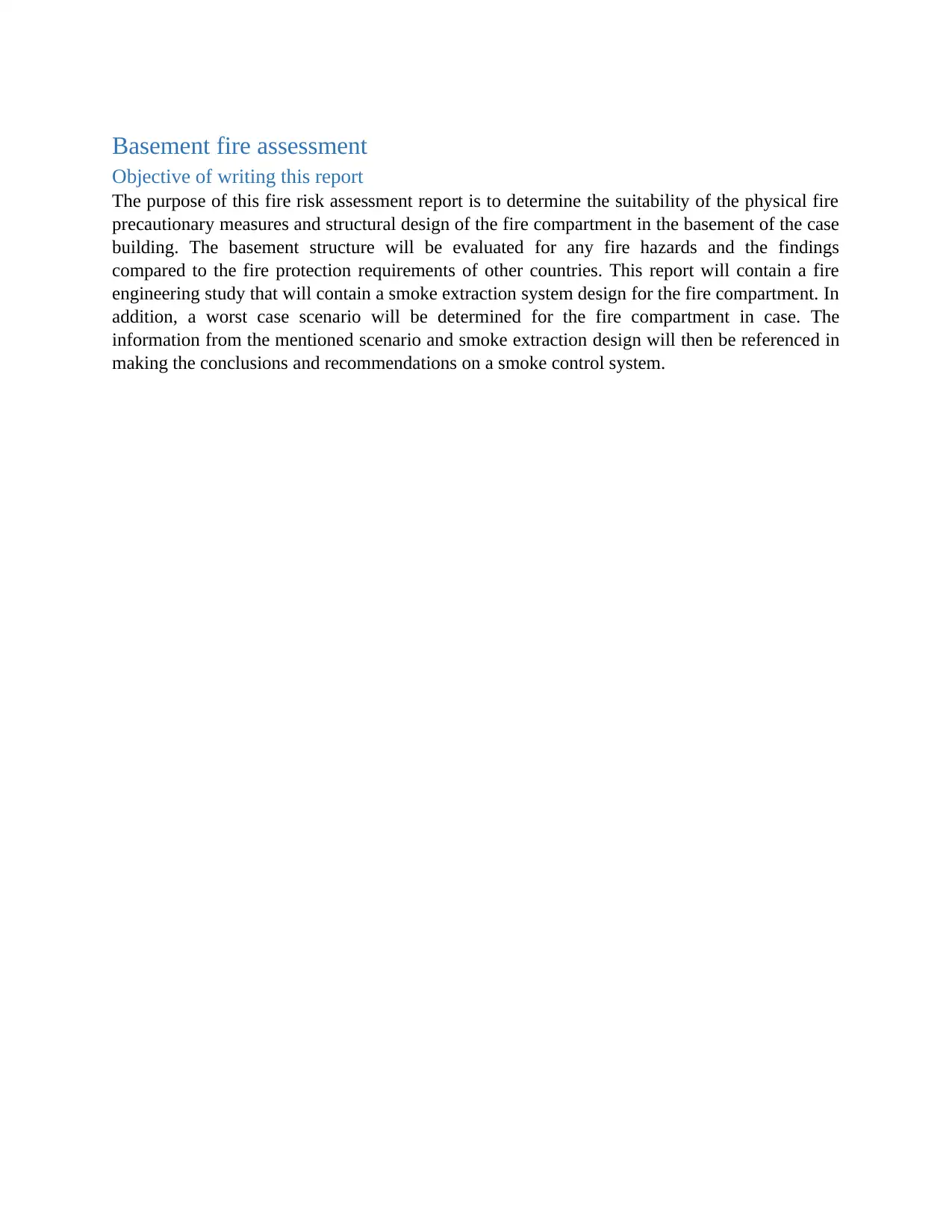
Basement fire assessment
Objective of writing this report
The purpose of this fire risk assessment report is to determine the suitability of the physical fire
precautionary measures and structural design of the fire compartment in the basement of the case
building. The basement structure will be evaluated for any fire hazards and the findings
compared to the fire protection requirements of other countries. This report will contain a fire
engineering study that will contain a smoke extraction system design for the fire compartment. In
addition, a worst case scenario will be determined for the fire compartment in case. The
information from the mentioned scenario and smoke extraction design will then be referenced in
making the conclusions and recommendations on a smoke control system.
Objective of writing this report
The purpose of this fire risk assessment report is to determine the suitability of the physical fire
precautionary measures and structural design of the fire compartment in the basement of the case
building. The basement structure will be evaluated for any fire hazards and the findings
compared to the fire protection requirements of other countries. This report will contain a fire
engineering study that will contain a smoke extraction system design for the fire compartment. In
addition, a worst case scenario will be determined for the fire compartment in case. The
information from the mentioned scenario and smoke extraction design will then be referenced in
making the conclusions and recommendations on a smoke control system.
Paraphrase This Document
Need a fresh take? Get an instant paraphrase of this document with our AI Paraphraser
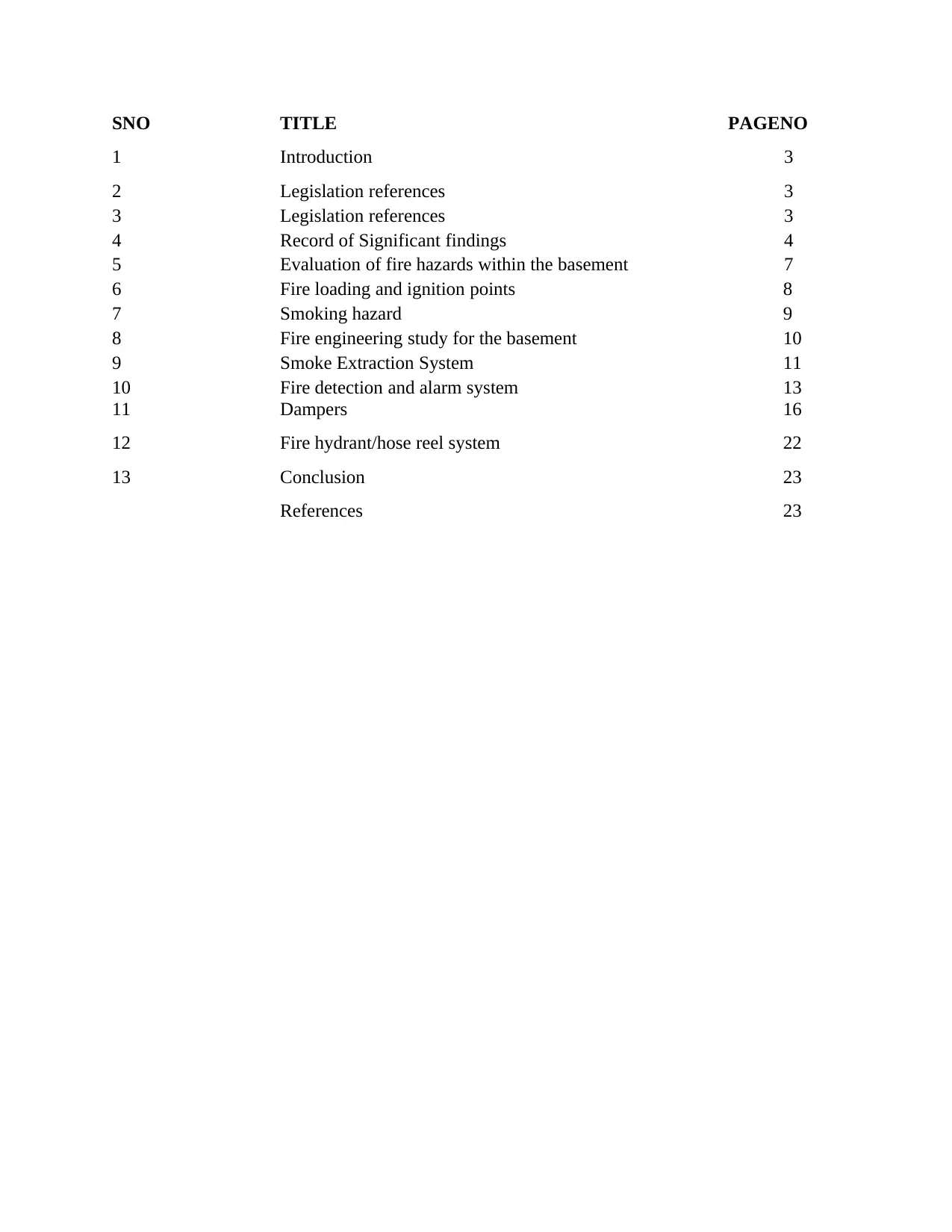
SNO TITLE PAGENO
1 Introduction 3
2 Legislation references 3
3 Legislation references 3
4 Record of Significant findings 4
5 Evaluation of fire hazards within the basement 7
6 Fire loading and ignition points 8
7 Smoking hazard 9
8 Fire engineering study for the basement 10
9 Smoke Extraction System 11
10 Fire detection and alarm system 13
11 Dampers 16
12 Fire hydrant/hose reel system 22
13 Conclusion 23
References 23
1 Introduction 3
2 Legislation references 3
3 Legislation references 3
4 Record of Significant findings 4
5 Evaluation of fire hazards within the basement 7
6 Fire loading and ignition points 8
7 Smoking hazard 9
8 Fire engineering study for the basement 10
9 Smoke Extraction System 11
10 Fire detection and alarm system 13
11 Dampers 16
12 Fire hydrant/hose reel system 22
13 Conclusion 23
References 23
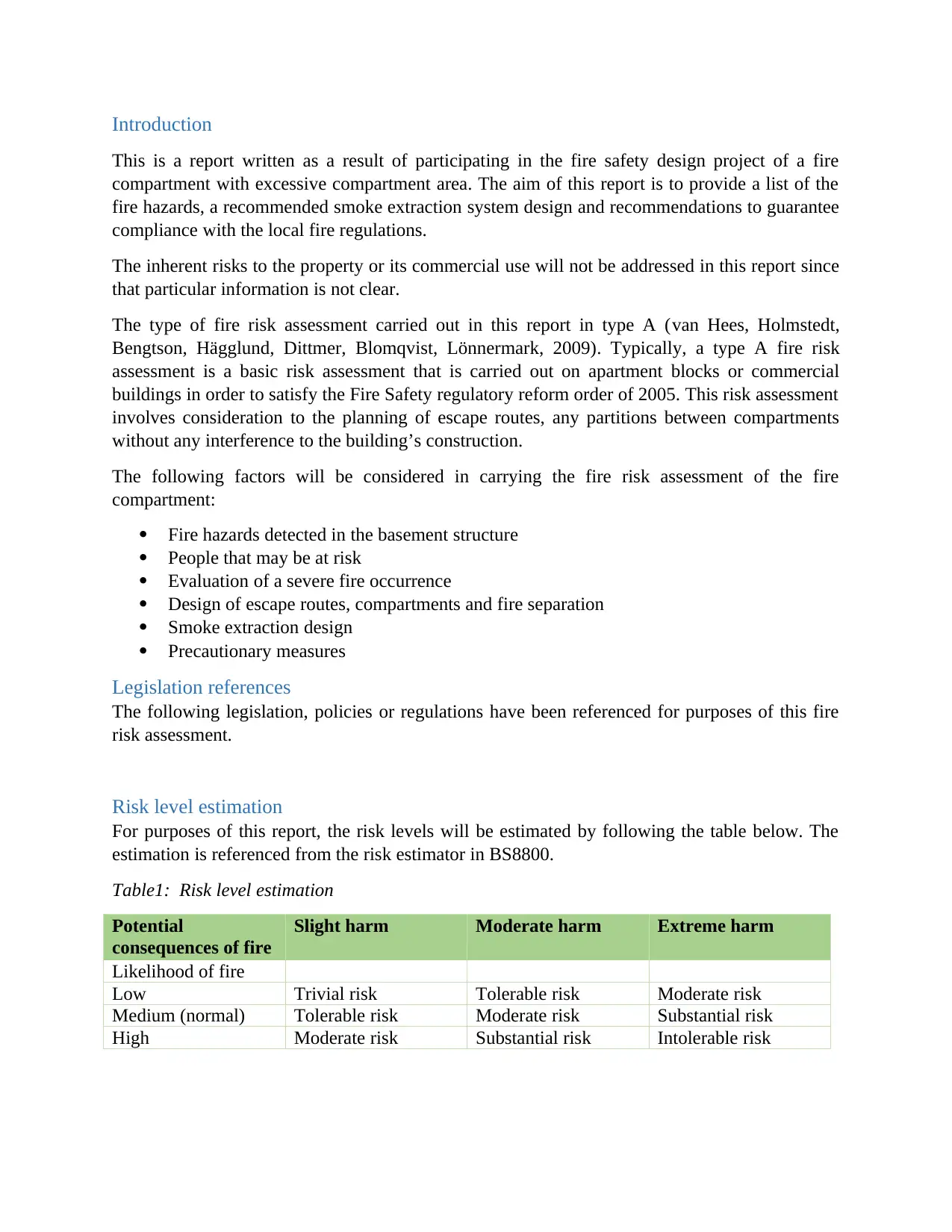
Introduction
This is a report written as a result of participating in the fire safety design project of a fire
compartment with excessive compartment area. The aim of this report is to provide a list of the
fire hazards, a recommended smoke extraction system design and recommendations to guarantee
compliance with the local fire regulations.
The inherent risks to the property or its commercial use will not be addressed in this report since
that particular information is not clear.
The type of fire risk assessment carried out in this report in type A (van Hees, Holmstedt,
Bengtson, Hägglund, Dittmer, Blomqvist, Lönnermark, 2009). Typically, a type A fire risk
assessment is a basic risk assessment that is carried out on apartment blocks or commercial
buildings in order to satisfy the Fire Safety regulatory reform order of 2005. This risk assessment
involves consideration to the planning of escape routes, any partitions between compartments
without any interference to the building’s construction.
The following factors will be considered in carrying the fire risk assessment of the fire
compartment:
Fire hazards detected in the basement structure
People that may be at risk
Evaluation of a severe fire occurrence
Design of escape routes, compartments and fire separation
Smoke extraction design
Precautionary measures
Legislation references
The following legislation, policies or regulations have been referenced for purposes of this fire
risk assessment.
Risk level estimation
For purposes of this report, the risk levels will be estimated by following the table below. The
estimation is referenced from the risk estimator in BS8800.
Table1: Risk level estimation
Potential
consequences of fire
Slight harm Moderate harm Extreme harm
Likelihood of fire
Low Trivial risk Tolerable risk Moderate risk
Medium (normal) Tolerable risk Moderate risk Substantial risk
High Moderate risk Substantial risk Intolerable risk
This is a report written as a result of participating in the fire safety design project of a fire
compartment with excessive compartment area. The aim of this report is to provide a list of the
fire hazards, a recommended smoke extraction system design and recommendations to guarantee
compliance with the local fire regulations.
The inherent risks to the property or its commercial use will not be addressed in this report since
that particular information is not clear.
The type of fire risk assessment carried out in this report in type A (van Hees, Holmstedt,
Bengtson, Hägglund, Dittmer, Blomqvist, Lönnermark, 2009). Typically, a type A fire risk
assessment is a basic risk assessment that is carried out on apartment blocks or commercial
buildings in order to satisfy the Fire Safety regulatory reform order of 2005. This risk assessment
involves consideration to the planning of escape routes, any partitions between compartments
without any interference to the building’s construction.
The following factors will be considered in carrying the fire risk assessment of the fire
compartment:
Fire hazards detected in the basement structure
People that may be at risk
Evaluation of a severe fire occurrence
Design of escape routes, compartments and fire separation
Smoke extraction design
Precautionary measures
Legislation references
The following legislation, policies or regulations have been referenced for purposes of this fire
risk assessment.
Risk level estimation
For purposes of this report, the risk levels will be estimated by following the table below. The
estimation is referenced from the risk estimator in BS8800.
Table1: Risk level estimation
Potential
consequences of fire
Slight harm Moderate harm Extreme harm
Likelihood of fire
Low Trivial risk Tolerable risk Moderate risk
Medium (normal) Tolerable risk Moderate risk Substantial risk
High Moderate risk Substantial risk Intolerable risk
⊘ This is a preview!⊘
Do you want full access?
Subscribe today to unlock all pages.

Trusted by 1+ million students worldwide
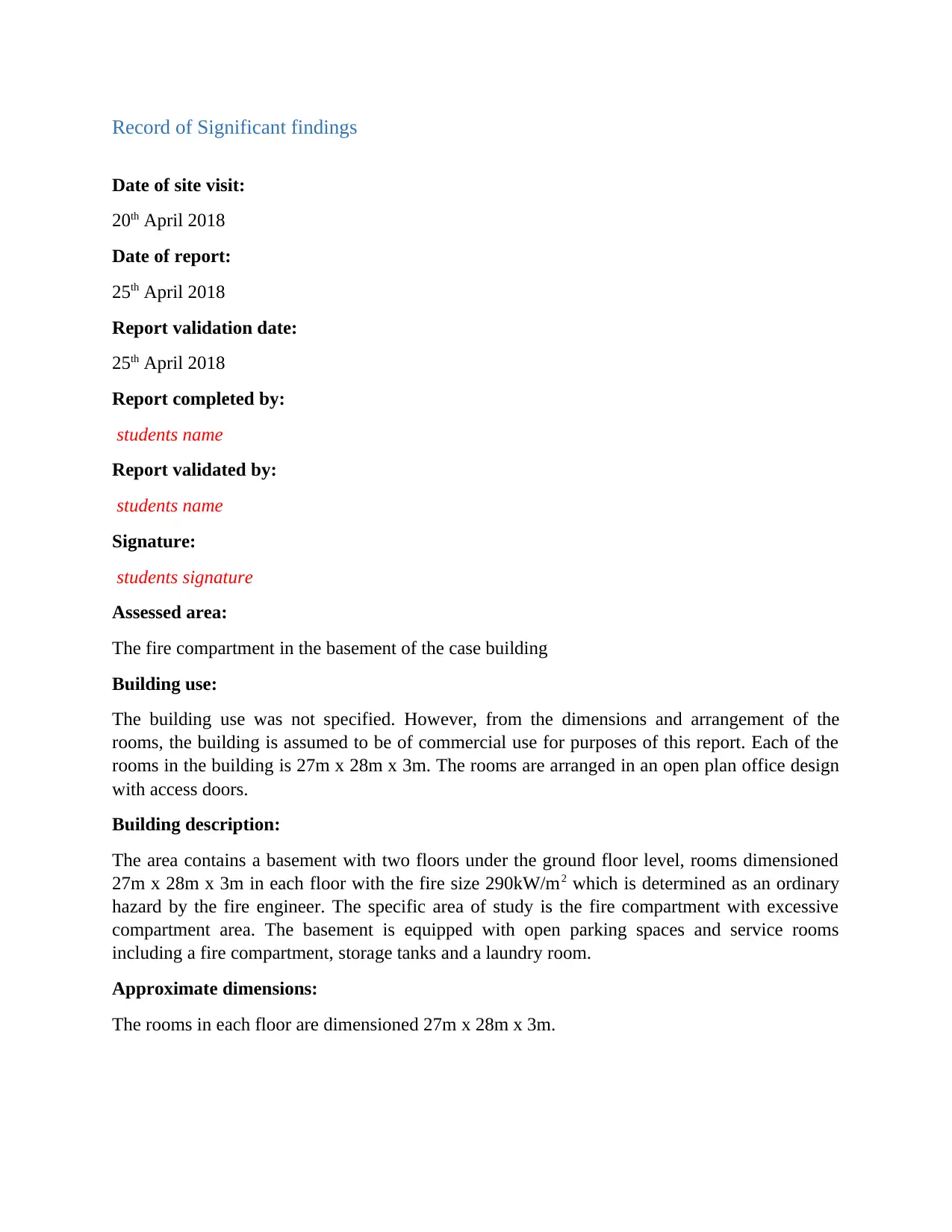
Record of Significant findings
Date of site visit:
20th April 2018
Date of report:
25th April 2018
Report validation date:
25th April 2018
Report completed by:
students name
Report validated by:
students name
Signature:
students signature
Assessed area:
The fire compartment in the basement of the case building
Building use:
The building use was not specified. However, from the dimensions and arrangement of the
rooms, the building is assumed to be of commercial use for purposes of this report. Each of the
rooms in the building is 27m x 28m x 3m. The rooms are arranged in an open plan office design
with access doors.
Building description:
The area contains a basement with two floors under the ground floor level, rooms dimensioned
27m x 28m x 3m in each floor with the fire size 290kW/m2 which is determined as an ordinary
hazard by the fire engineer. The specific area of study is the fire compartment with excessive
compartment area. The basement is equipped with open parking spaces and service rooms
including a fire compartment, storage tanks and a laundry room.
Approximate dimensions:
The rooms in each floor are dimensioned 27m x 28m x 3m.
Date of site visit:
20th April 2018
Date of report:
25th April 2018
Report validation date:
25th April 2018
Report completed by:
students name
Report validated by:
students name
Signature:
students signature
Assessed area:
The fire compartment in the basement of the case building
Building use:
The building use was not specified. However, from the dimensions and arrangement of the
rooms, the building is assumed to be of commercial use for purposes of this report. Each of the
rooms in the building is 27m x 28m x 3m. The rooms are arranged in an open plan office design
with access doors.
Building description:
The area contains a basement with two floors under the ground floor level, rooms dimensioned
27m x 28m x 3m in each floor with the fire size 290kW/m2 which is determined as an ordinary
hazard by the fire engineer. The specific area of study is the fire compartment with excessive
compartment area. The basement is equipped with open parking spaces and service rooms
including a fire compartment, storage tanks and a laundry room.
Approximate dimensions:
The rooms in each floor are dimensioned 27m x 28m x 3m.
Paraphrase This Document
Need a fresh take? Get an instant paraphrase of this document with our AI Paraphraser
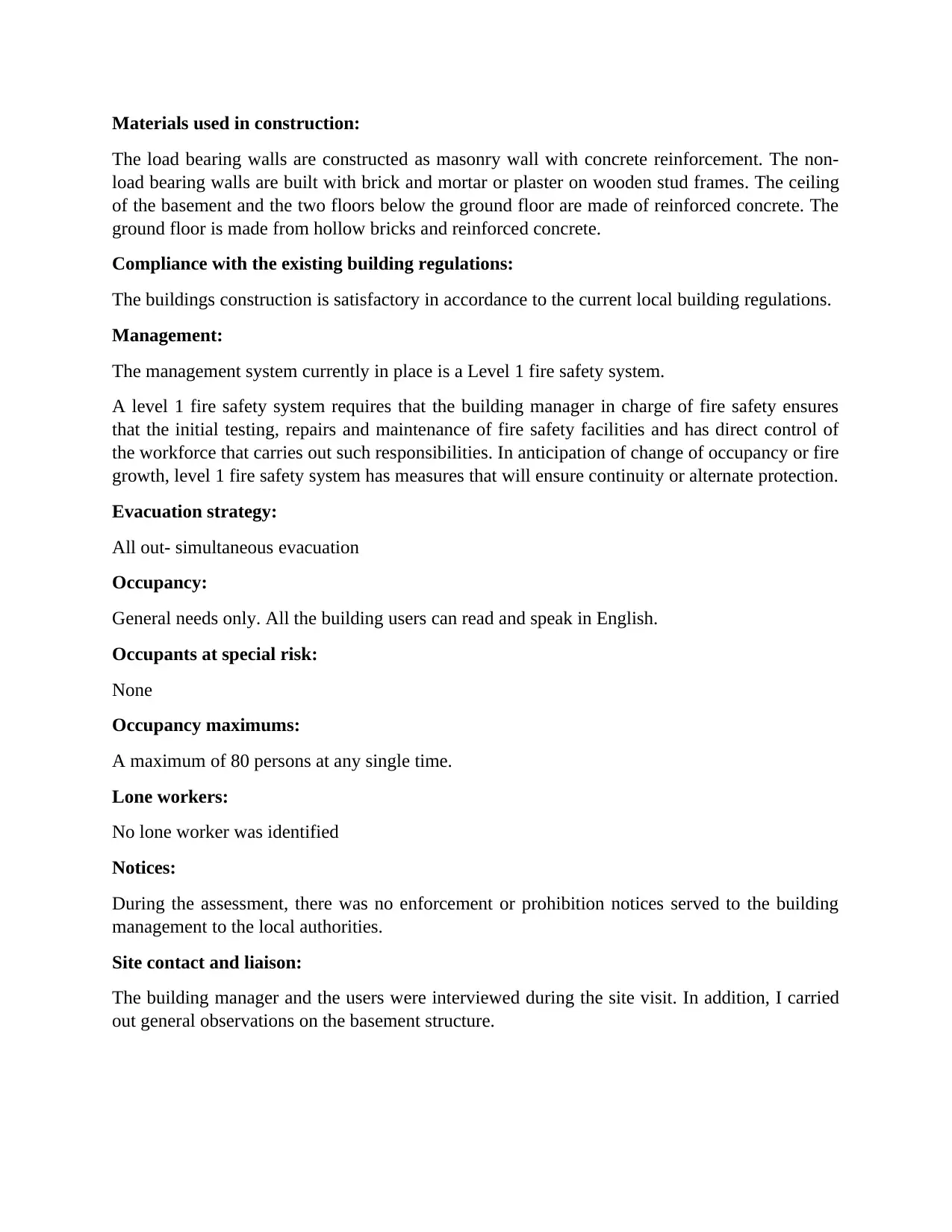
Materials used in construction:
The load bearing walls are constructed as masonry wall with concrete reinforcement. The non-
load bearing walls are built with brick and mortar or plaster on wooden stud frames. The ceiling
of the basement and the two floors below the ground floor are made of reinforced concrete. The
ground floor is made from hollow bricks and reinforced concrete.
Compliance with the existing building regulations:
The buildings construction is satisfactory in accordance to the current local building regulations.
Management:
The management system currently in place is a Level 1 fire safety system.
A level 1 fire safety system requires that the building manager in charge of fire safety ensures
that the initial testing, repairs and maintenance of fire safety facilities and has direct control of
the workforce that carries out such responsibilities. In anticipation of change of occupancy or fire
growth, level 1 fire safety system has measures that will ensure continuity or alternate protection.
Evacuation strategy:
All out- simultaneous evacuation
Occupancy:
General needs only. All the building users can read and speak in English.
Occupants at special risk:
None
Occupancy maximums:
A maximum of 80 persons at any single time.
Lone workers:
No lone worker was identified
Notices:
During the assessment, there was no enforcement or prohibition notices served to the building
management to the local authorities.
Site contact and liaison:
The building manager and the users were interviewed during the site visit. In addition, I carried
out general observations on the basement structure.
The load bearing walls are constructed as masonry wall with concrete reinforcement. The non-
load bearing walls are built with brick and mortar or plaster on wooden stud frames. The ceiling
of the basement and the two floors below the ground floor are made of reinforced concrete. The
ground floor is made from hollow bricks and reinforced concrete.
Compliance with the existing building regulations:
The buildings construction is satisfactory in accordance to the current local building regulations.
Management:
The management system currently in place is a Level 1 fire safety system.
A level 1 fire safety system requires that the building manager in charge of fire safety ensures
that the initial testing, repairs and maintenance of fire safety facilities and has direct control of
the workforce that carries out such responsibilities. In anticipation of change of occupancy or fire
growth, level 1 fire safety system has measures that will ensure continuity or alternate protection.
Evacuation strategy:
All out- simultaneous evacuation
Occupancy:
General needs only. All the building users can read and speak in English.
Occupants at special risk:
None
Occupancy maximums:
A maximum of 80 persons at any single time.
Lone workers:
No lone worker was identified
Notices:
During the assessment, there was no enforcement or prohibition notices served to the building
management to the local authorities.
Site contact and liaison:
The building manager and the users were interviewed during the site visit. In addition, I carried
out general observations on the basement structure.
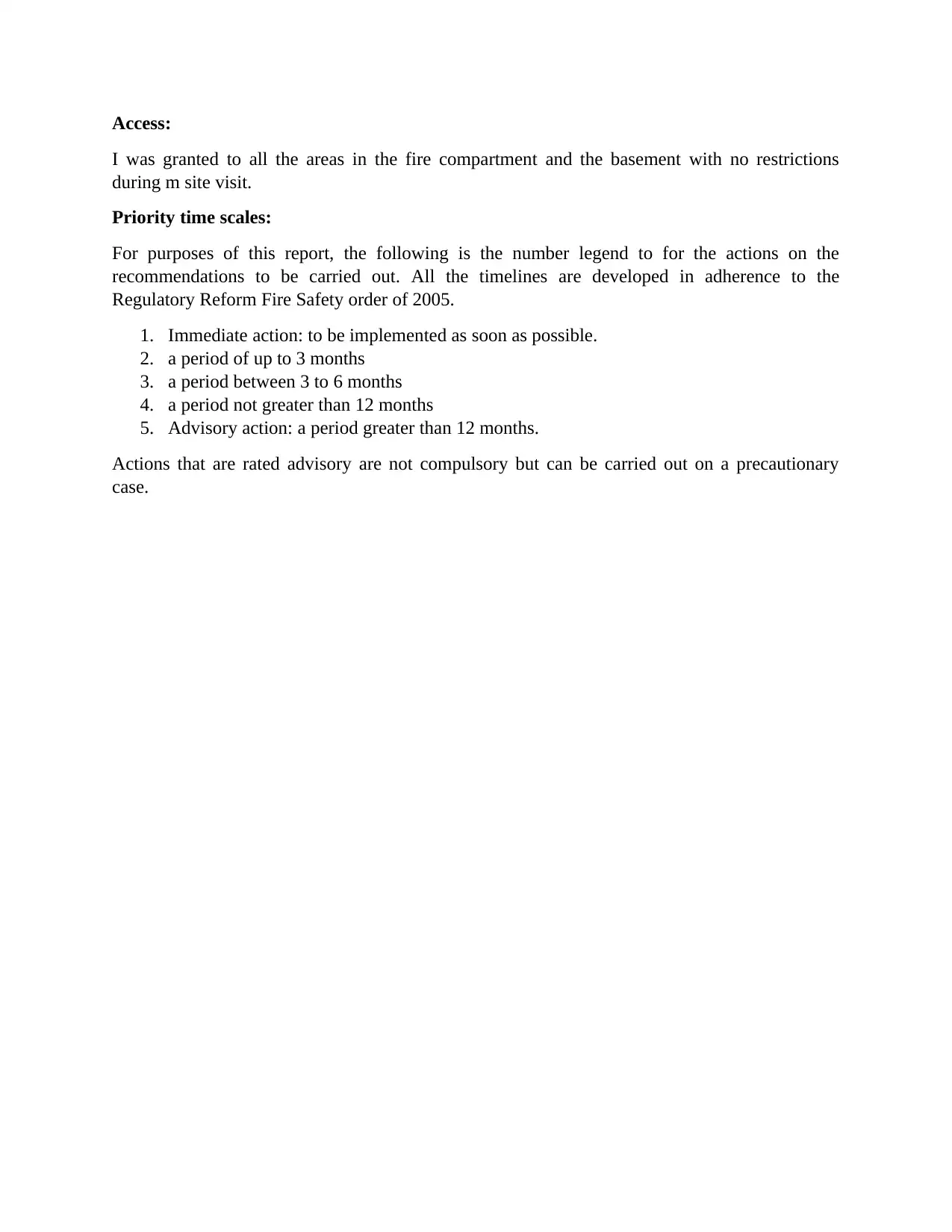
Access:
I was granted to all the areas in the fire compartment and the basement with no restrictions
during m site visit.
Priority time scales:
For purposes of this report, the following is the number legend to for the actions on the
recommendations to be carried out. All the timelines are developed in adherence to the
Regulatory Reform Fire Safety order of 2005.
1. Immediate action: to be implemented as soon as possible.
2. a period of up to 3 months
3. a period between 3 to 6 months
4. a period not greater than 12 months
5. Advisory action: a period greater than 12 months.
Actions that are rated advisory are not compulsory but can be carried out on a precautionary
case.
I was granted to all the areas in the fire compartment and the basement with no restrictions
during m site visit.
Priority time scales:
For purposes of this report, the following is the number legend to for the actions on the
recommendations to be carried out. All the timelines are developed in adherence to the
Regulatory Reform Fire Safety order of 2005.
1. Immediate action: to be implemented as soon as possible.
2. a period of up to 3 months
3. a period between 3 to 6 months
4. a period not greater than 12 months
5. Advisory action: a period greater than 12 months.
Actions that are rated advisory are not compulsory but can be carried out on a precautionary
case.
⊘ This is a preview!⊘
Do you want full access?
Subscribe today to unlock all pages.

Trusted by 1+ million students worldwide
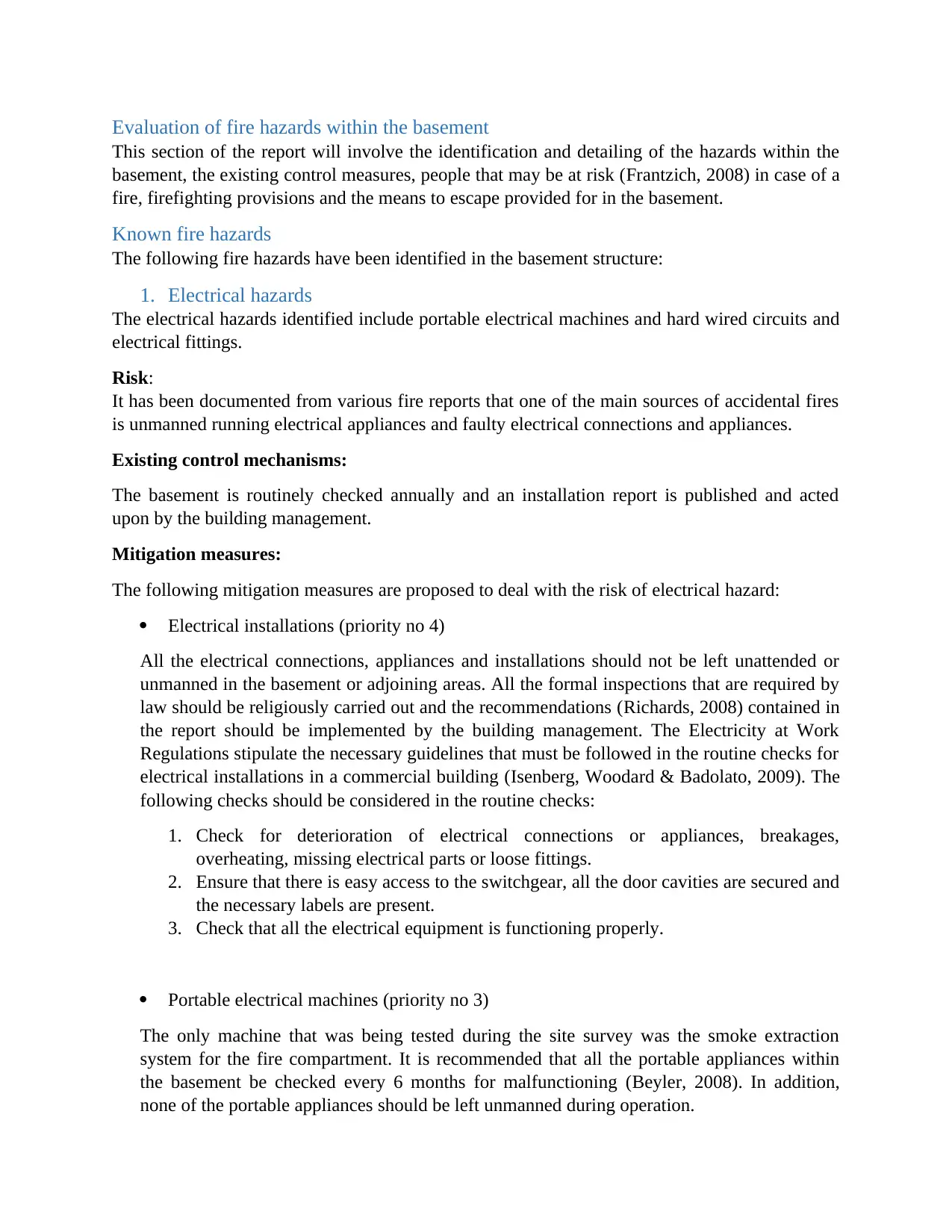
Evaluation of fire hazards within the basement
This section of the report will involve the identification and detailing of the hazards within the
basement, the existing control measures, people that may be at risk (Frantzich, 2008) in case of a
fire, firefighting provisions and the means to escape provided for in the basement.
Known fire hazards
The following fire hazards have been identified in the basement structure:
1. Electrical hazards
The electrical hazards identified include portable electrical machines and hard wired circuits and
electrical fittings.
Risk:
It has been documented from various fire reports that one of the main sources of accidental fires
is unmanned running electrical appliances and faulty electrical connections and appliances.
Existing control mechanisms:
The basement is routinely checked annually and an installation report is published and acted
upon by the building management.
Mitigation measures:
The following mitigation measures are proposed to deal with the risk of electrical hazard:
Electrical installations (priority no 4)
All the electrical connections, appliances and installations should not be left unattended or
unmanned in the basement or adjoining areas. All the formal inspections that are required by
law should be religiously carried out and the recommendations (Richards, 2008) contained in
the report should be implemented by the building management. The Electricity at Work
Regulations stipulate the necessary guidelines that must be followed in the routine checks for
electrical installations in a commercial building (Isenberg, Woodard & Badolato, 2009). The
following checks should be considered in the routine checks:
1. Check for deterioration of electrical connections or appliances, breakages,
overheating, missing electrical parts or loose fittings.
2. Ensure that there is easy access to the switchgear, all the door cavities are secured and
the necessary labels are present.
3. Check that all the electrical equipment is functioning properly.
Portable electrical machines (priority no 3)
The only machine that was being tested during the site survey was the smoke extraction
system for the fire compartment. It is recommended that all the portable appliances within
the basement be checked every 6 months for malfunctioning (Beyler, 2008). In addition,
none of the portable appliances should be left unmanned during operation.
This section of the report will involve the identification and detailing of the hazards within the
basement, the existing control measures, people that may be at risk (Frantzich, 2008) in case of a
fire, firefighting provisions and the means to escape provided for in the basement.
Known fire hazards
The following fire hazards have been identified in the basement structure:
1. Electrical hazards
The electrical hazards identified include portable electrical machines and hard wired circuits and
electrical fittings.
Risk:
It has been documented from various fire reports that one of the main sources of accidental fires
is unmanned running electrical appliances and faulty electrical connections and appliances.
Existing control mechanisms:
The basement is routinely checked annually and an installation report is published and acted
upon by the building management.
Mitigation measures:
The following mitigation measures are proposed to deal with the risk of electrical hazard:
Electrical installations (priority no 4)
All the electrical connections, appliances and installations should not be left unattended or
unmanned in the basement or adjoining areas. All the formal inspections that are required by
law should be religiously carried out and the recommendations (Richards, 2008) contained in
the report should be implemented by the building management. The Electricity at Work
Regulations stipulate the necessary guidelines that must be followed in the routine checks for
electrical installations in a commercial building (Isenberg, Woodard & Badolato, 2009). The
following checks should be considered in the routine checks:
1. Check for deterioration of electrical connections or appliances, breakages,
overheating, missing electrical parts or loose fittings.
2. Ensure that there is easy access to the switchgear, all the door cavities are secured and
the necessary labels are present.
3. Check that all the electrical equipment is functioning properly.
Portable electrical machines (priority no 3)
The only machine that was being tested during the site survey was the smoke extraction
system for the fire compartment. It is recommended that all the portable appliances within
the basement be checked every 6 months for malfunctioning (Beyler, 2008). In addition,
none of the portable appliances should be left unmanned during operation.
Paraphrase This Document
Need a fresh take? Get an instant paraphrase of this document with our AI Paraphraser
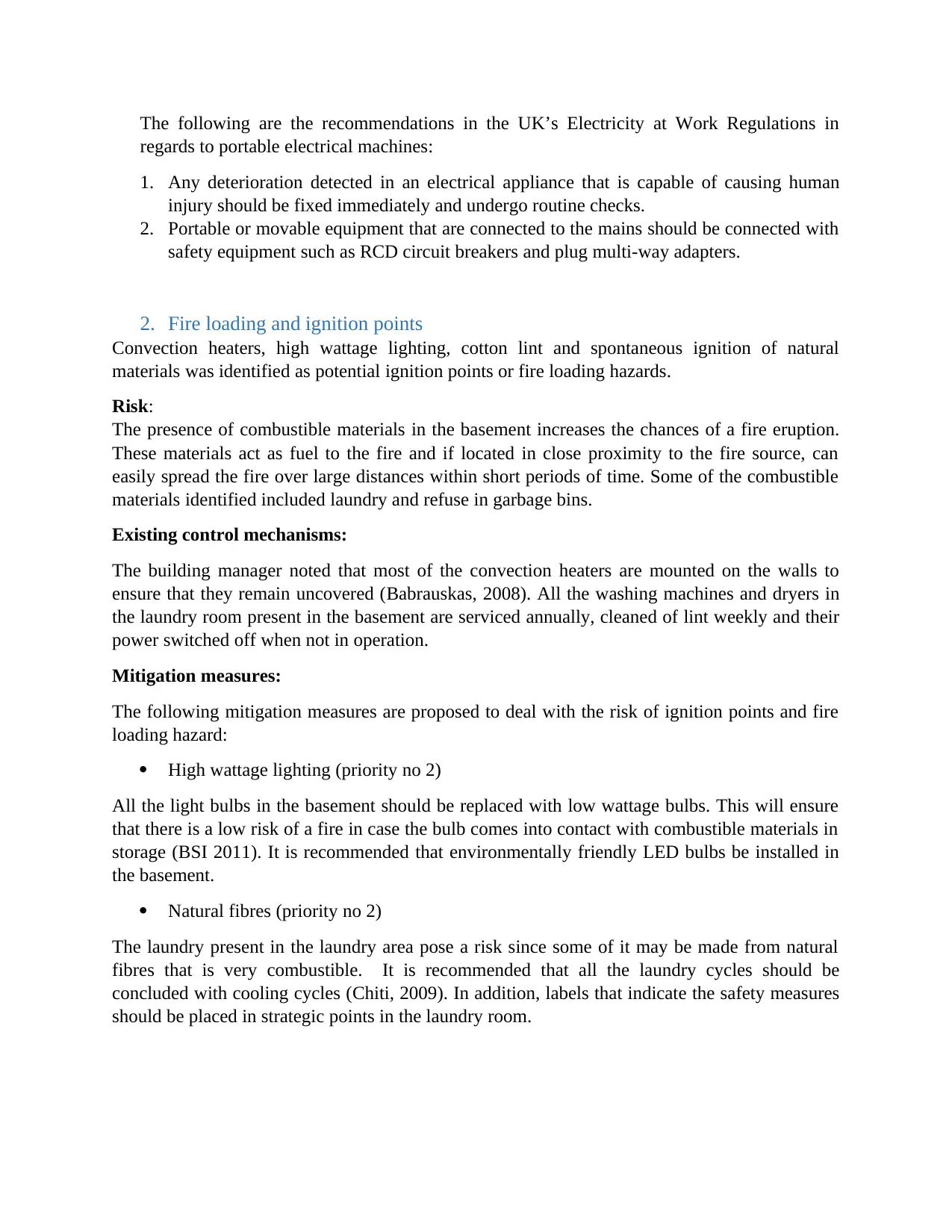
The following are the recommendations in the UK’s Electricity at Work Regulations in
regards to portable electrical machines:
1. Any deterioration detected in an electrical appliance that is capable of causing human
injury should be fixed immediately and undergo routine checks.
2. Portable or movable equipment that are connected to the mains should be connected with
safety equipment such as RCD circuit breakers and plug multi-way adapters.
2. Fire loading and ignition points
Convection heaters, high wattage lighting, cotton lint and spontaneous ignition of natural
materials was identified as potential ignition points or fire loading hazards.
Risk:
The presence of combustible materials in the basement increases the chances of a fire eruption.
These materials act as fuel to the fire and if located in close proximity to the fire source, can
easily spread the fire over large distances within short periods of time. Some of the combustible
materials identified included laundry and refuse in garbage bins.
Existing control mechanisms:
The building manager noted that most of the convection heaters are mounted on the walls to
ensure that they remain uncovered (Babrauskas, 2008). All the washing machines and dryers in
the laundry room present in the basement are serviced annually, cleaned of lint weekly and their
power switched off when not in operation.
Mitigation measures:
The following mitigation measures are proposed to deal with the risk of ignition points and fire
loading hazard:
High wattage lighting (priority no 2)
All the light bulbs in the basement should be replaced with low wattage bulbs. This will ensure
that there is a low risk of a fire in case the bulb comes into contact with combustible materials in
storage (BSI 2011). It is recommended that environmentally friendly LED bulbs be installed in
the basement.
Natural fibres (priority no 2)
The laundry present in the laundry area pose a risk since some of it may be made from natural
fibres that is very combustible. It is recommended that all the laundry cycles should be
concluded with cooling cycles (Chiti, 2009). In addition, labels that indicate the safety measures
should be placed in strategic points in the laundry room.
regards to portable electrical machines:
1. Any deterioration detected in an electrical appliance that is capable of causing human
injury should be fixed immediately and undergo routine checks.
2. Portable or movable equipment that are connected to the mains should be connected with
safety equipment such as RCD circuit breakers and plug multi-way adapters.
2. Fire loading and ignition points
Convection heaters, high wattage lighting, cotton lint and spontaneous ignition of natural
materials was identified as potential ignition points or fire loading hazards.
Risk:
The presence of combustible materials in the basement increases the chances of a fire eruption.
These materials act as fuel to the fire and if located in close proximity to the fire source, can
easily spread the fire over large distances within short periods of time. Some of the combustible
materials identified included laundry and refuse in garbage bins.
Existing control mechanisms:
The building manager noted that most of the convection heaters are mounted on the walls to
ensure that they remain uncovered (Babrauskas, 2008). All the washing machines and dryers in
the laundry room present in the basement are serviced annually, cleaned of lint weekly and their
power switched off when not in operation.
Mitigation measures:
The following mitigation measures are proposed to deal with the risk of ignition points and fire
loading hazard:
High wattage lighting (priority no 2)
All the light bulbs in the basement should be replaced with low wattage bulbs. This will ensure
that there is a low risk of a fire in case the bulb comes into contact with combustible materials in
storage (BSI 2011). It is recommended that environmentally friendly LED bulbs be installed in
the basement.
Natural fibres (priority no 2)
The laundry present in the laundry area pose a risk since some of it may be made from natural
fibres that is very combustible. It is recommended that all the laundry cycles should be
concluded with cooling cycles (Chiti, 2009). In addition, labels that indicate the safety measures
should be placed in strategic points in the laundry room.
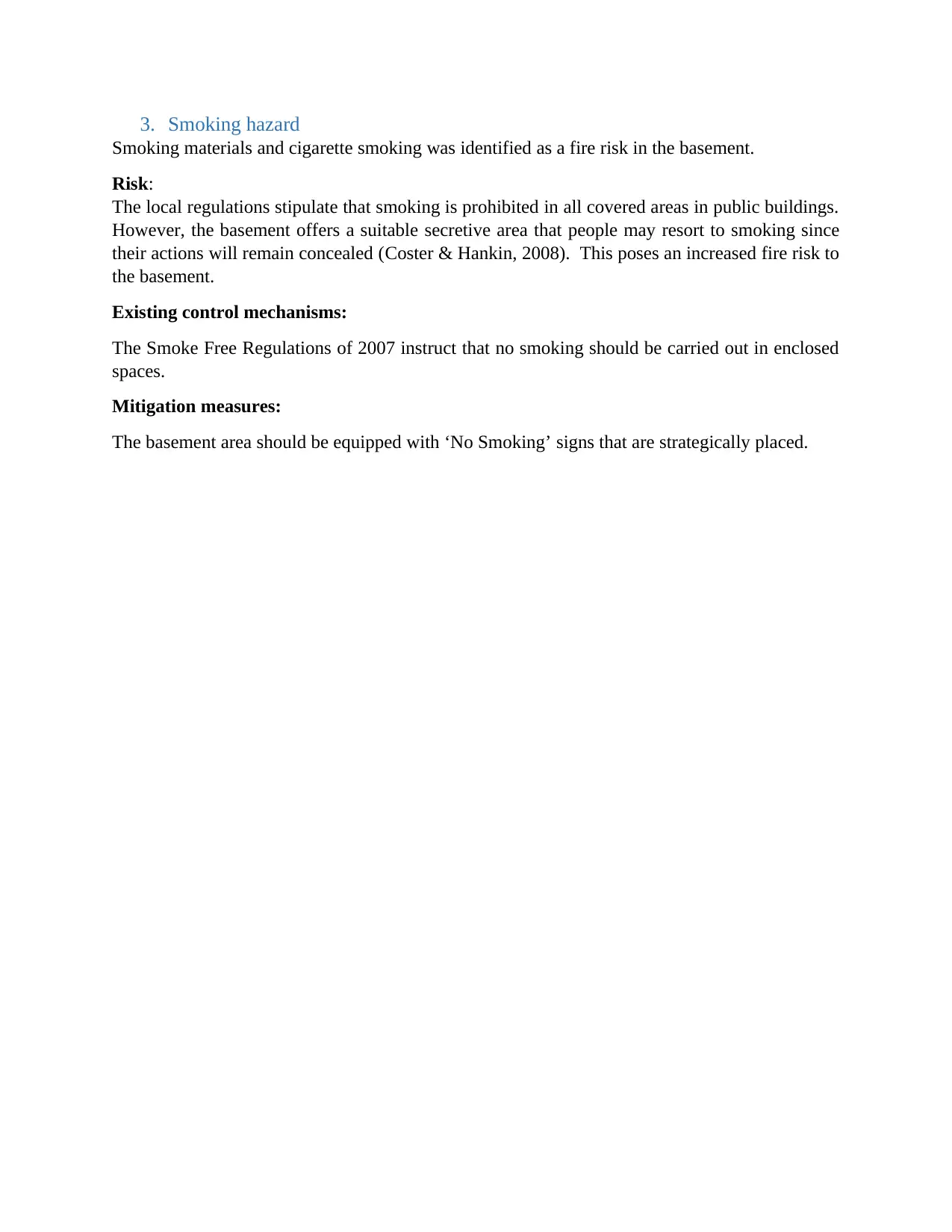
3. Smoking hazard
Smoking materials and cigarette smoking was identified as a fire risk in the basement.
Risk:
The local regulations stipulate that smoking is prohibited in all covered areas in public buildings.
However, the basement offers a suitable secretive area that people may resort to smoking since
their actions will remain concealed (Coster & Hankin, 2008). This poses an increased fire risk to
the basement.
Existing control mechanisms:
The Smoke Free Regulations of 2007 instruct that no smoking should be carried out in enclosed
spaces.
Mitigation measures:
The basement area should be equipped with ‘No Smoking’ signs that are strategically placed.
Smoking materials and cigarette smoking was identified as a fire risk in the basement.
Risk:
The local regulations stipulate that smoking is prohibited in all covered areas in public buildings.
However, the basement offers a suitable secretive area that people may resort to smoking since
their actions will remain concealed (Coster & Hankin, 2008). This poses an increased fire risk to
the basement.
Existing control mechanisms:
The Smoke Free Regulations of 2007 instruct that no smoking should be carried out in enclosed
spaces.
Mitigation measures:
The basement area should be equipped with ‘No Smoking’ signs that are strategically placed.
⊘ This is a preview!⊘
Do you want full access?
Subscribe today to unlock all pages.

Trusted by 1+ million students worldwide
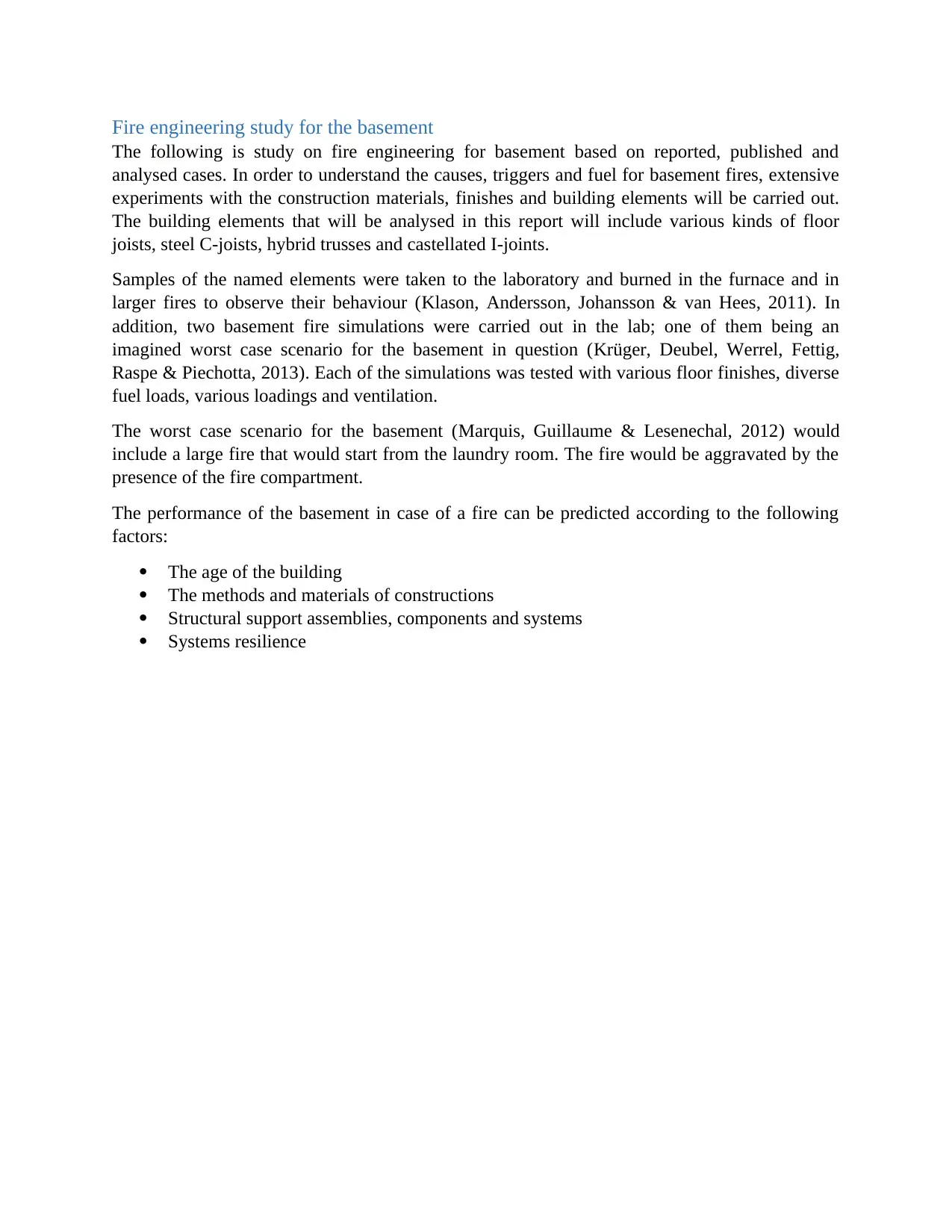
Fire engineering study for the basement
The following is study on fire engineering for basement based on reported, published and
analysed cases. In order to understand the causes, triggers and fuel for basement fires, extensive
experiments with the construction materials, finishes and building elements will be carried out.
The building elements that will be analysed in this report will include various kinds of floor
joists, steel C-joists, hybrid trusses and castellated I-joints.
Samples of the named elements were taken to the laboratory and burned in the furnace and in
larger fires to observe their behaviour (Klason, Andersson, Johansson & van Hees, 2011). In
addition, two basement fire simulations were carried out in the lab; one of them being an
imagined worst case scenario for the basement in question (Krüger, Deubel, Werrel, Fettig,
Raspe & Piechotta, 2013). Each of the simulations was tested with various floor finishes, diverse
fuel loads, various loadings and ventilation.
The worst case scenario for the basement (Marquis, Guillaume & Lesenechal, 2012) would
include a large fire that would start from the laundry room. The fire would be aggravated by the
presence of the fire compartment.
The performance of the basement in case of a fire can be predicted according to the following
factors:
The age of the building
The methods and materials of constructions
Structural support assemblies, components and systems
Systems resilience
The following is study on fire engineering for basement based on reported, published and
analysed cases. In order to understand the causes, triggers and fuel for basement fires, extensive
experiments with the construction materials, finishes and building elements will be carried out.
The building elements that will be analysed in this report will include various kinds of floor
joists, steel C-joists, hybrid trusses and castellated I-joints.
Samples of the named elements were taken to the laboratory and burned in the furnace and in
larger fires to observe their behaviour (Klason, Andersson, Johansson & van Hees, 2011). In
addition, two basement fire simulations were carried out in the lab; one of them being an
imagined worst case scenario for the basement in question (Krüger, Deubel, Werrel, Fettig,
Raspe & Piechotta, 2013). Each of the simulations was tested with various floor finishes, diverse
fuel loads, various loadings and ventilation.
The worst case scenario for the basement (Marquis, Guillaume & Lesenechal, 2012) would
include a large fire that would start from the laundry room. The fire would be aggravated by the
presence of the fire compartment.
The performance of the basement in case of a fire can be predicted according to the following
factors:
The age of the building
The methods and materials of constructions
Structural support assemblies, components and systems
Systems resilience
Paraphrase This Document
Need a fresh take? Get an instant paraphrase of this document with our AI Paraphraser
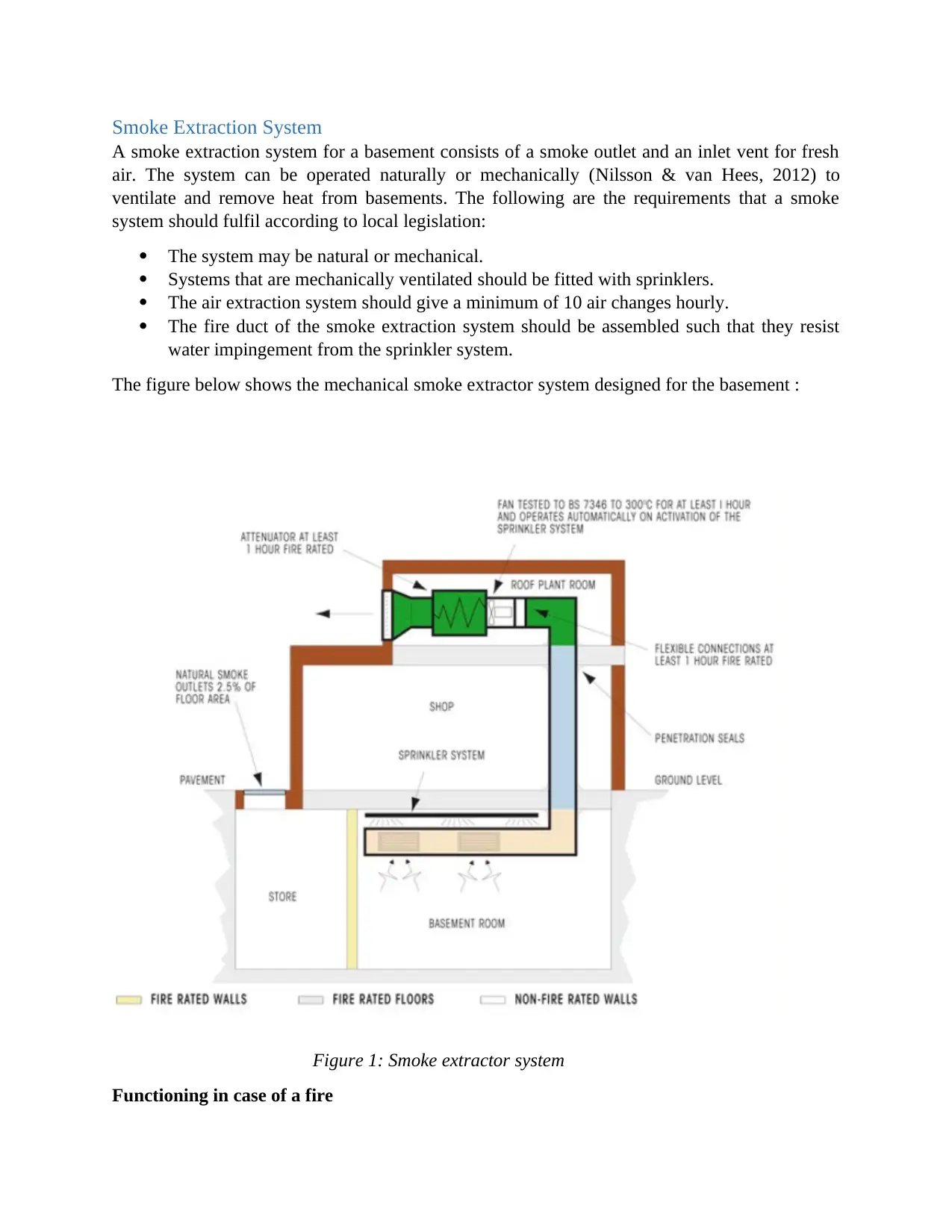
Smoke Extraction System
A smoke extraction system for a basement consists of a smoke outlet and an inlet vent for fresh
air. The system can be operated naturally or mechanically (Nilsson & van Hees, 2012) to
ventilate and remove heat from basements. The following are the requirements that a smoke
system should fulfil according to local legislation:
The system may be natural or mechanical.
Systems that are mechanically ventilated should be fitted with sprinklers.
The air extraction system should give a minimum of 10 air changes hourly.
The fire duct of the smoke extraction system should be assembled such that they resist
water impingement from the sprinkler system.
The figure below shows the mechanical smoke extractor system designed for the basement :
Figure 1: Smoke extractor system
Functioning in case of a fire
A smoke extraction system for a basement consists of a smoke outlet and an inlet vent for fresh
air. The system can be operated naturally or mechanically (Nilsson & van Hees, 2012) to
ventilate and remove heat from basements. The following are the requirements that a smoke
system should fulfil according to local legislation:
The system may be natural or mechanical.
Systems that are mechanically ventilated should be fitted with sprinklers.
The air extraction system should give a minimum of 10 air changes hourly.
The fire duct of the smoke extraction system should be assembled such that they resist
water impingement from the sprinkler system.
The figure below shows the mechanical smoke extractor system designed for the basement :
Figure 1: Smoke extractor system
Functioning in case of a fire
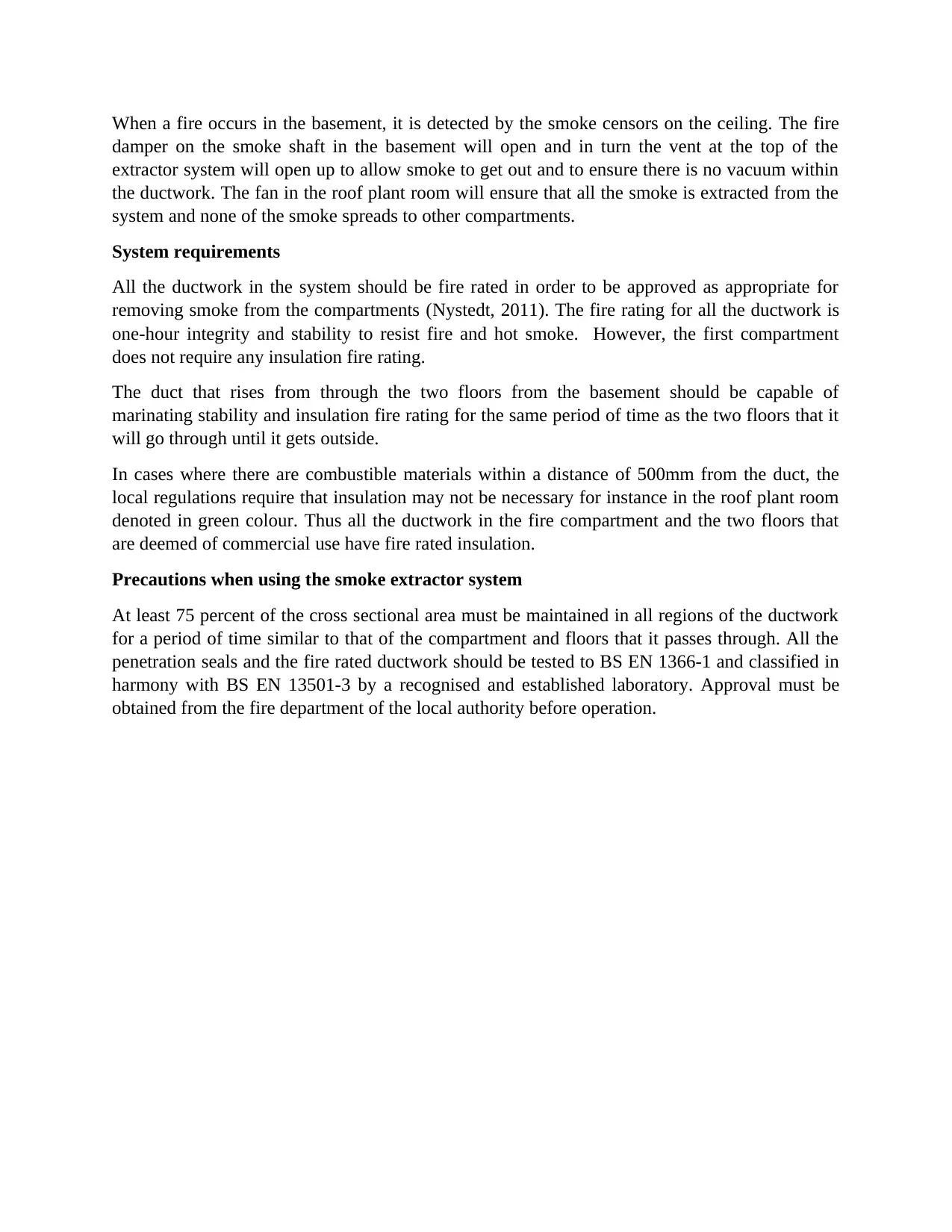
When a fire occurs in the basement, it is detected by the smoke censors on the ceiling. The fire
damper on the smoke shaft in the basement will open and in turn the vent at the top of the
extractor system will open up to allow smoke to get out and to ensure there is no vacuum within
the ductwork. The fan in the roof plant room will ensure that all the smoke is extracted from the
system and none of the smoke spreads to other compartments.
System requirements
All the ductwork in the system should be fire rated in order to be approved as appropriate for
removing smoke from the compartments (Nystedt, 2011). The fire rating for all the ductwork is
one-hour integrity and stability to resist fire and hot smoke. However, the first compartment
does not require any insulation fire rating.
The duct that rises from through the two floors from the basement should be capable of
marinating stability and insulation fire rating for the same period of time as the two floors that it
will go through until it gets outside.
In cases where there are combustible materials within a distance of 500mm from the duct, the
local regulations require that insulation may not be necessary for instance in the roof plant room
denoted in green colour. Thus all the ductwork in the fire compartment and the two floors that
are deemed of commercial use have fire rated insulation.
Precautions when using the smoke extractor system
At least 75 percent of the cross sectional area must be maintained in all regions of the ductwork
for a period of time similar to that of the compartment and floors that it passes through. All the
penetration seals and the fire rated ductwork should be tested to BS EN 1366-1 and classified in
harmony with BS EN 13501-3 by a recognised and established laboratory. Approval must be
obtained from the fire department of the local authority before operation.
damper on the smoke shaft in the basement will open and in turn the vent at the top of the
extractor system will open up to allow smoke to get out and to ensure there is no vacuum within
the ductwork. The fan in the roof plant room will ensure that all the smoke is extracted from the
system and none of the smoke spreads to other compartments.
System requirements
All the ductwork in the system should be fire rated in order to be approved as appropriate for
removing smoke from the compartments (Nystedt, 2011). The fire rating for all the ductwork is
one-hour integrity and stability to resist fire and hot smoke. However, the first compartment
does not require any insulation fire rating.
The duct that rises from through the two floors from the basement should be capable of
marinating stability and insulation fire rating for the same period of time as the two floors that it
will go through until it gets outside.
In cases where there are combustible materials within a distance of 500mm from the duct, the
local regulations require that insulation may not be necessary for instance in the roof plant room
denoted in green colour. Thus all the ductwork in the fire compartment and the two floors that
are deemed of commercial use have fire rated insulation.
Precautions when using the smoke extractor system
At least 75 percent of the cross sectional area must be maintained in all regions of the ductwork
for a period of time similar to that of the compartment and floors that it passes through. All the
penetration seals and the fire rated ductwork should be tested to BS EN 1366-1 and classified in
harmony with BS EN 13501-3 by a recognised and established laboratory. Approval must be
obtained from the fire department of the local authority before operation.
⊘ This is a preview!⊘
Do you want full access?
Subscribe today to unlock all pages.

Trusted by 1+ million students worldwide
1 out of 27
Your All-in-One AI-Powered Toolkit for Academic Success.
+13062052269
info@desklib.com
Available 24*7 on WhatsApp / Email
![[object Object]](/_next/static/media/star-bottom.7253800d.svg)
Unlock your academic potential
Copyright © 2020–2025 A2Z Services. All Rights Reserved. Developed and managed by ZUCOL.

